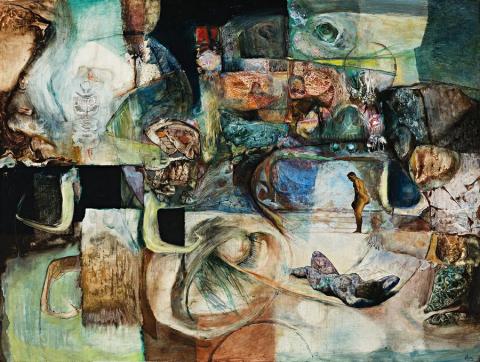FUGUE ON THE THEME OF ARIADNE, 1956
JAMES GLEESON
oil on composition board
92.0 x 122.0 cm
signed lower right: Gleeson
signed and inscribed verso: JAMES GLEESON – “FUGUE ON THE THEME OF ARIADNE”
Macquarie Galleries, Sydney
Private collection, Sydney
James Gleeson, Macquarie Galleries, Sydney, 21 November – 16 December 1956, cat. 100
Tales from ancient Greek and Roman mythology excite the imagination even today, explaining the noble, venial and other lesser ways of the gods and goddesses to us mere mortals. They are, of course, projections of humanity in all its beauty, passion and ugliness. For the Surrealist, these myths provided unrivalled sources for their explorations of the id, those inherited impulses of instinct from the unconscious. Long Australia's leading Surrealist, James Gleeson found them a fertile source throughout his career, the occasions and settings for epic journeys into the subconscious. Paintings in his 1956 exhibition at the Macquarie Galleries, Sydney, included subjects inspired by Prometheus, Odysseus, and Achilles as well as the painting on offer. In Fugue on the Theme of Ariadne, 1956, Gleeson chose a subject that fascinated artists over the millennia. From the fifth century BC onwards, Ariadne and Theseus, and Ariadne and Bacchus (Dionysus) excited not only the vase painters of ancient Athens, but also artists throughout the Greek and Roman worlds of classical art.
It reached its apotheosis in Titian's Venetian masterpiece, Bacchus and Ariadne, 1520-23, in the collection of the National Gallery, London. Ariadne inspired Anton Chekhov, Richard Strauss and others to magnificent literature and opera. With its combination of human sacrifice, the Minotaur, love at first sight, abandonment, and then marriage to Bacchus god of wine, the story of Ariadne had every thing to inspire works of epic grandeur. Gleeson gave it added interest by presenting it in the guise of a fugue in its twentieth century journey through the mind. His contrapuntal composition is as labyrinthine as the Minotaur's home.
DAVID THOMAS
